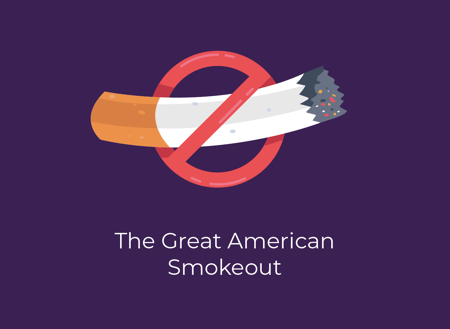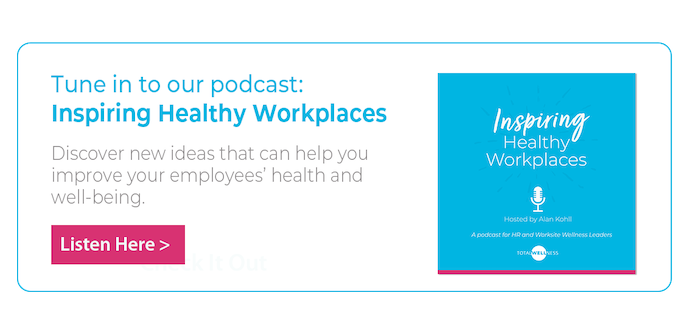 More than 34 million people smoke cigarettes.
More than 34 million people smoke cigarettes.
Of those, over 16 million live with a smoking-related disease.
On November 21, the Great American Smokeout is set to help smokers to quit their nicotine habit. While quitting smoking isn’t easy, the immediate and long-term health benefits are worth the quitting struggle.
Encourage your employees who smoke to kick the unhealthy habit for good this month.
Unsure how to help?
This post will list the best tools and tips that will actually help employees quit smoking once and for all.
Why Join the Great American Smokeout?
On November 21, smokers are invited to unite to kick their habit for good. Encourage your employees who have been thinking about quitting by giving them tips to help quit smoking in the days leading up to the Great American Smokeout.
A few reasons to encourage employees to quit:
- Lower health and life insurance costs
- Can improve taste and sense of smell
- No smokey residue on clothing
- Immediately improves health
- Save money on nicotine products
Best of all, the physical benefits of quitting smoking start right away. Within 20 minutes, a person’s heart rate returns to normal. In 2-3 weeks, the odds of having a heart attack lower. It also reduces the chance of developing lung cancer later in life.
Read more here about the benefits of a smoke-free worksite.
Plan It Out
Encourage employees who want to quit to create and review a plan to quit smoking. Additionally, setting up a support network in advance in the workplace can be helpful.
Some ways to set up a support network:
- Accountability sign-up - Create a sign-up to encourage buddy systems for quitting.
- Host info sessions - Wellness committees can inspire employees by hosting a quick information session on the Great American Smokeout and available resources.
- Share the quit hotline - 1-800-QUIT NOW (784-8669). Smokers can talk to an expert on how to develop their quitting plan. Best of all, it’s free.
Tips to Help Quit Smoking to Share With Employees
Share the below content in a newsletter, paste these ideas on a wall, or post it on social media. However you do it, send these tips along with a positive message that you support your employees who are giving it their best effort.
These tips and tools can help employees to kick the habit in the butt for good:
Find Your Big “WHY”
This addictive habit is hard to break, so reflecting on your “why” is important. It should be specific — more than “because I should” — to feel worth following through on. When your reason to quit is big enough, you have something positive to fall back on when kicking the habit gets tough.
Try Nicotine Replacements
Some state programs offer quit aids to reduce the chances of a smoker going back to the habit. These options can be a successful part of a stop smoking plan if quitting cold turkey doesn’t work for you.
Over-the-counter options include:
- Nicotine gum
- Nicotine patches
- Nicotine lozenges
If over-the-counter nicotine replacements don’t work for you, a prescription inhaler or nasal spray might be worth considering. Talk to your doctor to help make the best choice for you.
Ask Your Doctor
If you’re planning on quitting smoking during the Great American Smokeout, it might be helpful to have backup support from a medical professional. Your doctor can present a variety of methods and help you choose which would be best for you. Additionally, there are alternatives to medication or nicotine patches, too.
Here are a few alternative options:
- Hypnosis
- Acupuncture
- Magnet therapy
- Cold laser therapy
- Quit smoking apps
- Behavior modification therapy
Ask your doctor how to minimize withdrawal symptoms, especially if your attempts to quit have been unsuccessful before.
Avoid Your Smoking Triggers
Identify what encourages your smoking habit. It’s different for everyone, but if you plan in advance to have another activity to minimize the temptation, it can deviate your behavior in the right direction.
Some triggers may include:
- Stress
- Drinking
- Certain friends
- Cigarette smoke
If possible, try to avoid or mitigate being around those triggers the first few weeks after you quit. It’s always hardest during the first few weeks as your body is processing the nicotine out of your system.
Use Your Support System
Smokers who quit the habit are generally on edge the first few weeks. It’s a difficult transition to stop smoking, so be sure to tell your family and friends. Ask for their support and patience.
Not sure where to find support? Try these resources:
- SmokefreeTXT - Receive supportive texts during your quitting journey for 6-8 weeks. You’ll get between 3-5 messages daily.
- Smokefree Apps - Two apps called QuitGuide and quitSTART are available to offer 24/7 support. Both are available for Android and iOS phones.
- Chat with an expert - Have questions about quitting smoking? Call and speak to the National Cancer Institute’s trained counselors at 877-448-7848.
You don’t need to feel alone in your journey to quit. Partner up with another smoker to hold each other accountable. Tell a friend or family member and ask for their daily encouragement.
Make Other Healthy Changes
Feeling fidgety because you don’t have a cigarette in hand? It may be time to find new hobbies and implementing changes to keep your mind occupied.
A few ideas:
- Try moving - Exercise can help improve your mood and take your mind off smoking.
- Fix your diet - Since you won’t be putting a cigarette in your mouth, it can be tempting to fill that void with food. If you do, try to make it a point to eat healthy snacks and foods.
- Do a good deed - Non-profit organizations always need hard workers to help out. You’ll be too busy helping others that you will forget all about your desire to smoke.
- Watch your savings grow - Any time you feel like you want to run out to buy cigarettes, put the cash into a clear jar instead. Once it’s full, empty it and treat yourself with the savings.
If stress always has you turning to your pack of cigarettes, look at other positive ways to relieve stress naturally. Your health — and your wallet — will thank you.
Don’t Give Up
This physical addiction is a tough one to give up. For many people, the quitting process can come with unpleasant side effects — including moodiness. If your plan wasn’t working, switch it up and try again. Positively confirm your quit status, too. Instead of saying, “I’m quitting,” you can say: “I don’t smoke” or “I’m not a smoker.” It confirms in your mind that you’ve already stopped the habit.
Encourage Employees to Join the Great American Smokeout
The best way to quit smoking is to have support.
As an employer, you can give your employees an incredible amount of support by promoting participation in the Great American Smokeout. Even if you just pass out tips to help quit smoking, you’re sending out encouragement that might push someone toward quitting.
Human resources and wellness committees can come together for the Great American Smokeout to create creative campaigns. Survey office smokers to see what would be most beneficial to them as they try quitting.
And even when the Great American Smokeout is over and the strongest withdrawal symptoms have passed, staying smoke-free can be a challenge. Remind employees of available resources, including smoking cessation programs, and the healthcare cost reductions, too.
For more details on helping someone quit smoking, check out www.smokefree.gov.
What creative ideas have you used in your office to get employees to stop smoking? Share your wisdom in the comments below!



